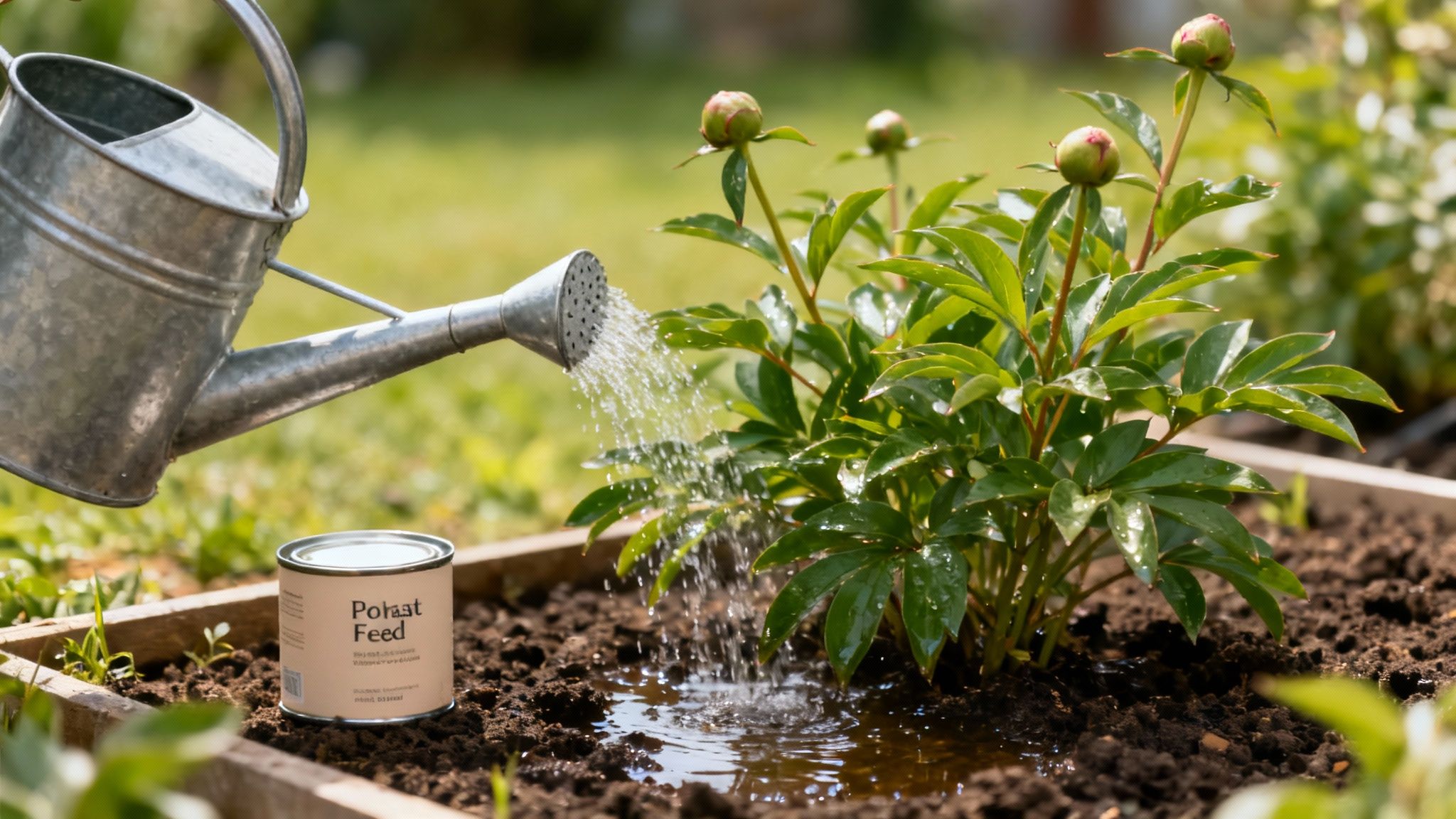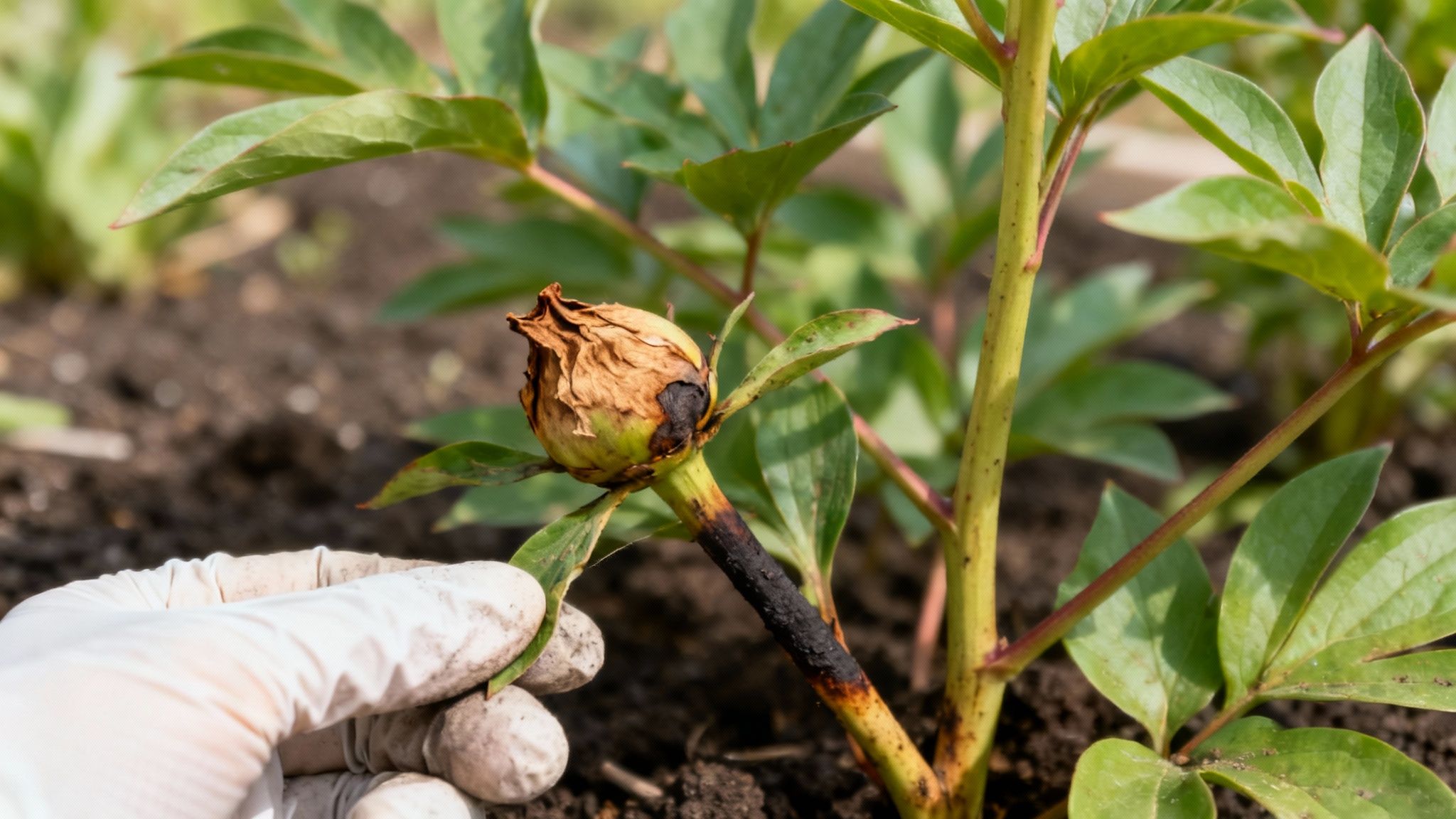If you're finding yourself staring at a lush, green peony bush with absolutely no flowers, you're not alone. It’s a classic gardening mystery. More often than not, the culprit is one of three common issues: planting them too deeply, not giving them enough sun, or accidentally using a high-nitrogen fertiliser. The good news is that these are usually simple fixes.
Getting to the Root of Why Peony Buds Don't Form
It's one of the most frustrating sights for any UK gardener—a magnificent peony, full of vibrant green leaves, that just won't produce a single bloom. Before you think about giving up and digging it out, take a breath. The solution is often surprisingly straightforward.
A flowerless peony isn't usually a sign of a sick plant. Instead, think of it as the plant's way of telling you that one of its essential needs isn't quite being met. Peonies are incredibly tough and can live for decades, but they do have their particular preferences. By working through a few key factors, you can usually figure out what's wrong and get your plant on track for a stunning display next year.

Where to Start Your Investigation
When your peonies are all leaves and no flowers, start your detective work by focusing on these three areas:
- Planting and Location: How and where your peony is planted is the number one factor affecting its ability to flower.
- Nutrients and Feeding: What you're feeding your peony—and even the plants nearby—can make all the difference.
- Age and Patience: Sometimes, the only thing your peony needs is a bit more time to get established.
To help you quickly diagnose the problem, here's a simple table matching what you see with the most likely cause.
Common Reasons for Peonies Failing to Bloom
Once you've run through these common issues, you'll have a much clearer idea of what's holding your plant back.
Peonies are true northern flowers. They not only tolerate cold winters but actually need them to set their buds properly. Hardy in zones 3 through 8, they thrive in the chilly conditions found across most of the UK.
A little observation now will pay off with armfuls of beautiful flowers later. For more advice on timing your gardening tasks throughout the year, our UK planting calendar is a great resource.
Getting Planting Depth and Location Right
Of all the reasons peonies decide not to bloom, two issues crop up time and time again: how deep you've planted them and where you've put them. Nailing these two fundamentals from the get-go is the single best thing you can do to guarantee a future filled with those glorious, blousy flowers. But don't despair if your plant is already in the ground—these are problems you can absolutely fix.
Peonies are surprisingly fussy about their planting depth. The tuberous roots have small, reddish buds on them, which gardeners call 'eyes'. For our UK soil and climate, it's absolutely vital that these eyes are positioned no more than 5cm below the soil surface. Planting them any deeper is a classic, and critical, mistake.
When a peony is buried too deep, it pours all its energy into just pushing its leaves up towards the light. This leaves nothing in the tank for producing flowers. The plant might look lush and healthy, but it will stubbornly refuse to bloom year after year.

Why Is Peony Planting Depth So Critical?
Honestly, if you ask any seasoned gardener in the UK why a peony isn't flowering, this is the first thing they'll suggest. Peonies form their flower buds on tissue right near the soil surface, and burying them too deep simply smothers this process. I've seen it myself—deeply planted peonies can take ages to recover, sometimes 3 to 5 years before they finally put on a proper show.
The fix is straightforward, but you need to wait for the right time. In the autumn, carefully lift the entire plant with a garden fork, doing your best to keep the root ball in one piece. Then, simply replant it in the same spot, but this time, make sure those reddish 'eyes' are sitting at that crucial shallow depth.
The Right Place for Sun and Space
Just as important as depth is location. Peonies are absolute sun-worshippers. They need a spot that gets at least six hours of direct, solid sunlight every day to build up the energy reserves for flowering. Pop one in a shady corner, and you'll get weak, leggy growth with few, if any, blooms.
It's also worth thinking about how your garden has evolved. That perfect, sunny spot where you planted your peony five years ago might not be so sunny anymore.
- Creeping Shade: Has that little silver birch or apple tree you planted years ago suddenly shot up, casting a much larger shadow?
- New Structures: Maybe a new fence, shed, or neighbour's extension has gone up, blocking out that lovely afternoon sun?
A peony’s location isn’t just about the initial planting; it's about its environment year after year. Regularly assess the sunlight in your garden, as a once-perfect spot can gradually become a no-bloom zone without you realising.
If you realise your peony is now languishing in the shade, the solution is the same: move it in the autumn. Find it a new home in the sunniest part of your garden. Picking the right spot is a cornerstone of great garden design, a principle that's especially true for creating beautiful cottage garden designs where peonies so often take centre stage. By sorting out depth and light, you'll solve the two most common reasons peonies fail to flower.
How to Feed and Water Peonies for More Flowers
It’s natural to want to pamper our favourite plants, but with peonies, too much kindness can lead to a garden full of disappointment. If you’re looking at a peony with gorgeous, lush leaves but not a single flower bud, your feeding and watering habits are the first place to look.
Getting the balance right is key, and thankfully, it's simpler than you might think.
A classic mistake I see all the time is using the wrong kind of fertiliser. Anything high in nitrogen is a no-go for peonies. Nitrogen is fantastic for leafy growth, which is why it's a major component of lawn feed. It basically tells your peony to pump all its energy into creating a big, green bush, leaving none for making flowers.
This is a very common reason for peonies not blooming, especially if they're planted in a border right next to a well-tended lawn. That lawn feed can easily wash into the flower bed, giving your peonies a dose of nitrogen they never asked for.

Choosing the Right Plant Food
Forget nitrogen; what your peony really needs is potassium (that’s the 'K' in the N-P-K ratio you see on fertiliser bags). Potassium is the magic ingredient that fuels flower production. A good quality, balanced fertiliser with a higher potassium number is just the ticket.
So, when is the best time to feed them?
- Early Spring: I give mine a light feed just as the new, red shoots are pushing through the soil. It's the perfect little boost to get them started.
- After Flowering: Once the show is over, another light application helps the plant store up energy in its roots for a spectacular display next year.
A sprinkle of bone meal or a specialised rose food usually does the trick perfectly. If you fancy a more organic approach, you can even make your own. Our guide to homemade plant food has some great recipes that will get your peonies blooming.
Mastering the Art of Watering
Peonies are quite particular about water—they absolutely despise having 'wet feet'. Their fleshy, tuberous roots are incredibly prone to rot if they sit in waterlogged soil. This can be a real challenge here in the UK with our often heavy, clay-based soils.
Honestly, you're far more likely to cause problems by overwatering a peony than by underwatering it. A young plant needs a bit of help to get established, but once mature, they are remarkably drought-tolerant thanks to their deep root systems.
My golden rule is to water deeply but infrequently. Let the top few inches of soil dry out completely before you even consider reaching for the watering can. This simple trick encourages the roots to delve deeper for moisture, building a much stronger and more resilient plant.
The easiest way to check is with the finger test. Just poke your finger about two inches into the soil near the plant's base. If it feels dry, it's time for a drink. If you feel any dampness, walk away and check again in a few days.
A little prep work goes a long way, too. When you first plant your peony, amending heavy soil with plenty of organic matter like well-rotted compost will work wonders for drainage, preventing the soggy conditions they hate.
The Importance of Pruning and Patience
What you do after your peonies have finished flowering—or failed to flower at all—is just as important as all the work you put in during spring. The decisions you make in late summer and autumn set the stage for next year’s performance, and a couple of common missteps can easily lead to a garden full of nothing but leaves.
One of the biggest mistakes I see gardeners make is being too tidy, too soon. It’s tempting to cut back all the foliage once it starts to look a bit scruffy, but you have to resist that urge. Those leaves are the plant's solar panels, working hard all summer to produce and send energy down to the roots for winter storage.
If you chop them off while they’re still green, you’re basically pulling the plug, starving the plant of the very power it needs to form next year’s flower buds. This is one of the top culprits behind a disappointing show the following season.
When Is the Right Time to Cut Back Peony Foliage?
The golden rule is to wait until the foliage has turned yellow or brown and died back naturally. In the UK, this usually happens after the first good frost has hit. Only then have the leaves finished their job.
At that point, you can safely cut the stems right down to about an inch from the ground. This isn't just about aesthetics; it’s good housekeeping. Tidying up the dead material helps prevent fungal diseases, like peony wilt, from finding a cosy place to overwinter. Timing is everything in the garden, a principle we also explore in our guide on the best time to prune fruit trees.
The Underrated Virtue of a Gardener's Patience
Sometimes, the hardest part of gardening is knowing when to do nothing at all. This is especially true with peonies. If you've just planted a new one or recently moved an existing plant, a lack of flowers isn’t a sign you’ve failed—it’s a sign the plant is being sensible.
A newly planted peony will pour all its energy into establishing a strong, healthy root system for the first couple of years. Expecting a huge display of blooms right away just isn't realistic. The plant is playing the long game, and so should you.
This establishment period is a vital investment in the plant's future. It can take up to three years for a peony to mature enough to put on the spectacular, reliable display we all dream of.
Here’s a realistic timeline for a new peony:
- Year 1: You'll see plenty of healthy green leaves, but it’s very unlikely you’ll get any flowers. All the action is happening underground.
- Year 2: You might be rewarded with one or two tentative blooms. This is a brilliant sign that your plant is settling in nicely.
- Year 3: By now, the plant should be established enough to produce a proper show of flowers, and it will only get better from here.
So, if your plant is young but looks healthy, the best tool you have is patience. As long as you’ve got the planting depth, sunlight, and feeding sorted, the blooms will come.
5. Pesky Pests and Diseases Halting the Show
You've done everything right—the planting depth is spot on, they're bathing in sunshine, and you haven't overfed them. Yet, the buds form and then... nothing. If this sounds familiar, it’s time to play detective, as you might have an uninvited guest causing trouble.
When a peony’s health is the reason it’s not flowering, the culprit is often a fungal disease, especially with our notoriously damp and cool British springs. A bit of vigilance now can save your blooms later.

The number one offender is Botrytis paeoniae, a frustrating fungus more commonly known as peony wilt or botrytis blight. It absolutely adores the very conditions that define a British spring: cool, wet, and humid.
This nasty blight attacks the tender new shoots and fragile flower buds, causing them to blacken, wilt, and simply give up, often before they even have a chance to show their colour. In a particularly wet year, commercial growers have reported crop losses from botrytis exceeding 20%, so it's a serious problem for gardeners too.
How to Spot and Tackle Peony Wilt
The secret to beating botrytis lies in good old-fashioned garden hygiene and making your garden an inhospitable place for the fungus to thrive. Since it loves damp, stagnant air, improving airflow around your peonies is your most powerful weapon.
Keep an eye out for these tell-tale signs:
- Blackened Stems: As new growth emerges in spring, check the base of the stems. If you spot them turning black and collapsing, that's a classic sign.
- Withered Buds: The buds might look promising at first, but then suddenly turn brown or black and feel alarmingly soft to the touch. They won't open and will eventually just drop off.
- Grey Mould: If the weather is especially grim and damp, you might even see a fuzzy grey mould forming on the dying parts of the plant.
To get a handle on it without reaching for harsh chemicals, prevention is key. When autumn rolls around, be absolutely ruthless about clearing away every last fallen peony leaf and stem. The fungal spores can easily spend the winter tucked away in this debris, just waiting to reinfect your plants next spring. A thorough autumn clean-up is a vital part of protecting plants in winter and setting them up for a healthy start.
Expert Tip: Whatever you do, don't throw diseased peony leaves into your home compost bin. The spores are hardy and can survive the composting process, meaning you'll just spread the problem around your garden later. This is one of the few times it’s far better to let the council's green waste service handle it.
To help you diagnose what might be going on, here’s a quick troubleshooting chart for common peony problems we see in the UK.
Peony Health Troubleshooting Guide
This chart should give you a good starting point. Remember, a healthy, well-cared-for plant is always your best defence against pests and diseases.
What's the Deal With Ants on My Peony Buds?
It’s a sight that can send a new peony owner into a panic: a small army of ants crawling all over those precious, unopened buds. It’s natural to assume they’re causing damage, but this is one garden "pest" you can happily ignore.
Those ants are simply drawn to a sweet, sugary nectar that the buds exude as part of their development. They're just there for a free meal and do absolutely zero harm to the plant or the flower inside. In fact, some gardeners believe they act as tiny bodyguards, warding off other pests that might actually cause damage.
So, put the spray bottle down. Once the flower opens and the nectar buffet closes, the ants will pack up and move on all by themselves.
Common Questions About Peony Blooming Problems
Even after running through the usual suspects, you might still be scratching your head over your bloom-less peonies. Every garden is its own little world, with unique conditions and challenges. Let's tackle some of the most common questions I hear from fellow gardeners, especially for those tricky situations that don't quite fit the standard mould.
Think of this as the troubleshooting guide for those lingering "what if" scenarios.
My Peony Bloomed Last Year, but Not This Year. What Happened?
This is a classic peony puzzle, but it’s rarely a sign that your plant is on its way out. More often than not, it points to a recent change in its environment.
First, think back to the weather. A late, hard frost is a notorious bloom-killer. It can easily zap the young, tender flower buds just as they’re forming, ending the show before it even begins.
Next, have a good look at the light conditions. Has that little sapling nearby suddenly shot up into a tree, casting your peony patch into shade? Peonies are sun-worshippers and really need at least six hours of direct sunlight to gather the energy to bloom.
Finally, review your fertilising habits. Did you recently feed the lawn? High-nitrogen lawn feed can easily wash into your garden beds. This tells the peony to grow big, beautiful leaves at the direct expense of its flowers.
How Long Does It Take for a Newly Planted Peony to Bloom?
If there's one virtue every peony grower needs, it's patience. It's completely normal for a newly planted peony to skip blooming in its first year. The plant is putting all its energy into establishing a strong, healthy root system—the powerhouse for decades of future beauty.
You might get a flower or two in the second year, but it often takes a full three years before the plant is mature and established enough to put on a truly glorious display.
This waiting game is a vital investment in your plant's long-term health. As long as the foliage looks green and you've planted it correctly (not too deep!), your patience will be rewarded with armfuls of stunning flowers.
Should I Get Rid of the Ants on My Peony Buds?
It can be alarming to see your precious peony buds covered in ants, and it sends many gardeners into a panic. But here’s the simple truth: the ants are completely harmless and are not the reason your peonies aren’t blooming.
They're just there for the sticky, sugary nectar the buds produce as they swell. It's a free meal for them, and they do absolutely no damage to the bud or the eventual flower.
In fact, some old-school gardeners believe the ants act as tiny bodyguards, chasing away other pests that could cause harm. There's no need to spray them or try to wash them off. Just let them be, and they’ll vanish on their own once the flowers open and the nectar dries up.




